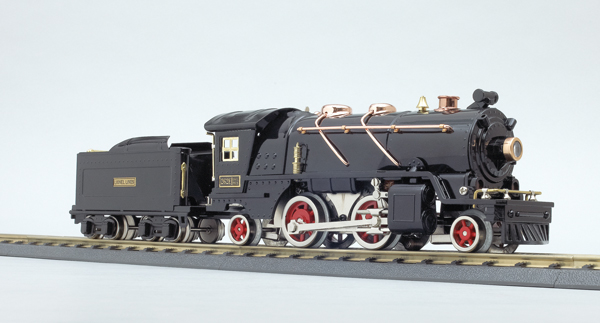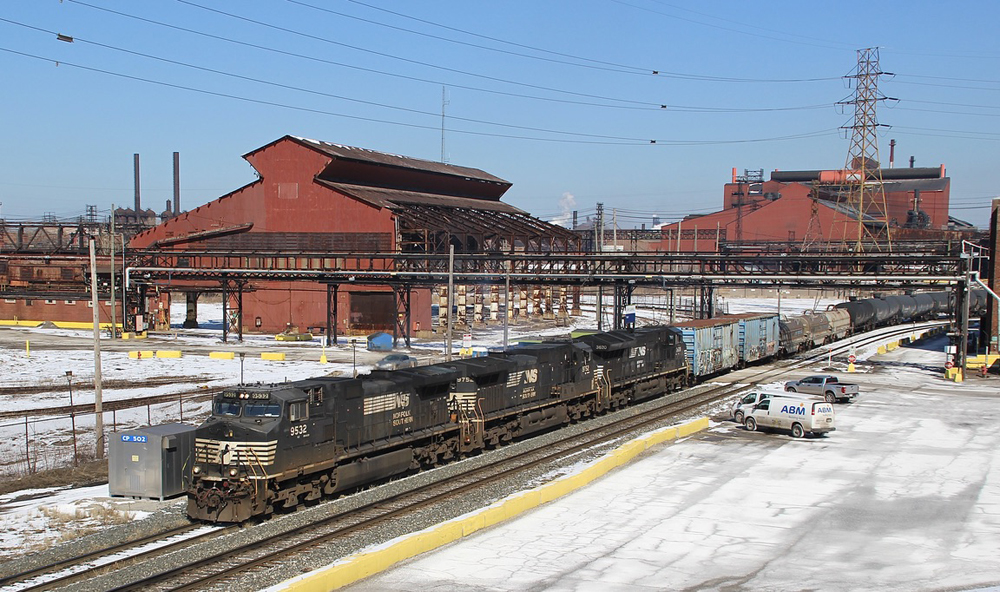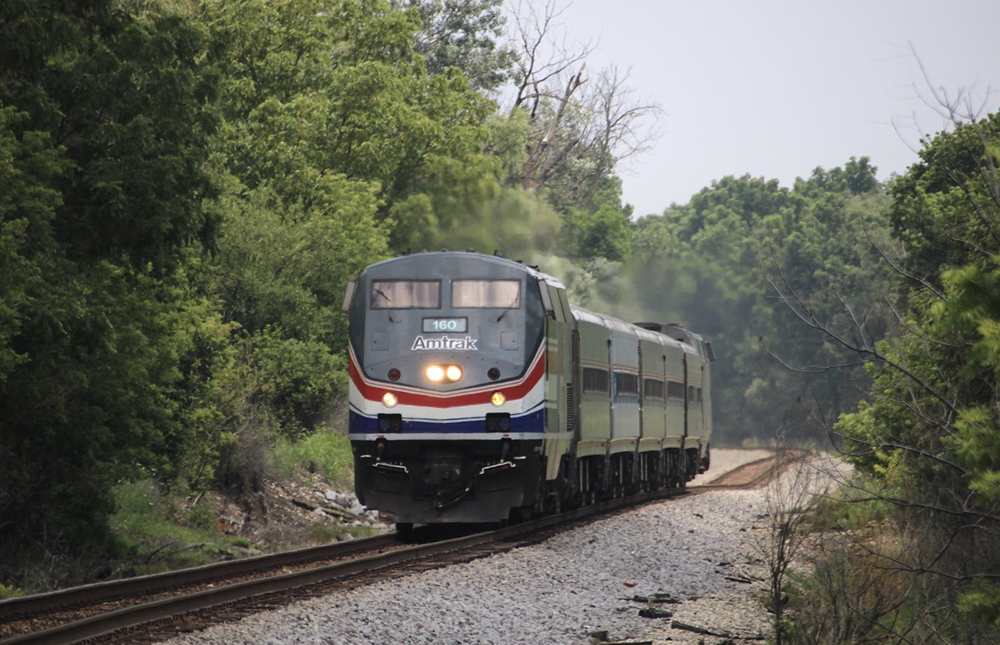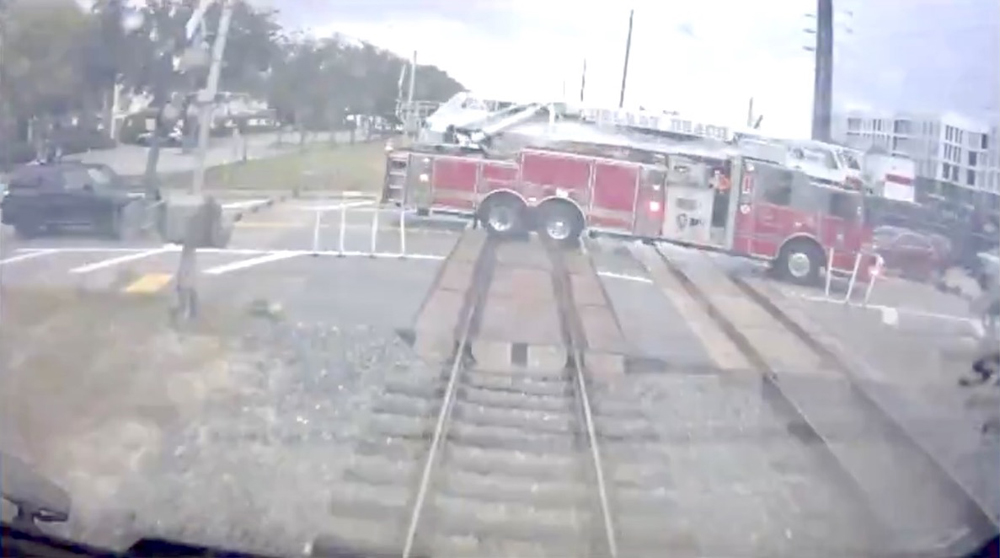Focus on fun
This rig re-creates a set from the late stone-age period of electric trains. A time where trains ran on track, but with newfangled technology that allowed you to change the direction of a train by remote control – from a transformer – some distance away from the train! Are we talking science fiction or what?
This is a starter set, which means it has everything you need to start running trains. It has a loop of track, a power supply, a locomotive and three cars, and even a DVD with track-planning software.
The locomotive
The first thing you need to know about this locomotive is that it is the conventional version. No Proto, no smoke, no bell, no chitty chatter, no firebox glow. This is old school, which is fine by me. But if you are Jonesing for the digital bells and whistles, the no. 11-5507-1 no. 269E Distant Control Freight Set with ProtoSound 3.0 delivers what you crave.
The no. 262E locomotive is a sturdy steel stallion with a 2-4-2 wheel arrangement. I doubt the model was based on any particular full-size locomotive. It is just a generic steamer.
The pilot has the businesslike appearance of blunt steel. It is topped by a brass-colored grab iron supported by stanchions. The smokebox face has rivet detail, but don’t confuse this with modern, precise detailing. The rivets are probably about as large as an O scale person’s head! The headlight is capped with a brass lid with a transparent pane.
The boiler is smooth, with boiler bands and rivets for the firebox. A brass compressor is on the engineer’s side of the running board.
Along the boiler top, you’ll find several add-on, brass-colored features, including handrails that run the length of the boiler, twin sand domes and downward running sand lines, a bell, and a smokestack cap. On the point of the boiler is either a simulated turbine or a feedwater heater.
The ultimate retro detail is the reverse unit level, which pops out of the shell just in front of the cab.
The cab has brass-colored windows and handrails, along with a brass number plate on each of its sides. There isn’t any pretense of cab detail.
The wheels and running gear are all natural metal color. The drivers and pilot and trailing wheels have nice red accents on the spokes.
Detailing opportunities are somewhat minimal for sheet metal, but there is texture detail on the sides and the upper sides of the coal bin. There are brass Lionel Lines placards on the sides, and a grab iron along the top of the water tank at the rear. You’ll find a Lionel circle-L emblem on the rear of the tender.
The paint finishes on both the engine and tender were as close to perfect as I’ve seen. I hated to get fingerprints on those models while just moving them around.
The freight cars
All the cars are stamped steel, with die-cast metal trucks and those funky-looking yet functional hook couplers.
The tanker: I’m going to make a broad generalization: Everyone loves tank cars, and the most beloved road name may be Sunoco (Remember – “When you stop at Sunoco, you go with confidence!”).
Don’t hate me, but the car is cute. It is on a flat stamped-steel frame with cradle supports on the front and rear. There is a dome in the center of the top and two smaller domes on either side. The tank is beer-can smooth and finely painted.
A grab iron runs around the entire tank, and ladders run down both sides of the central dome. I think a train of six or seven of these cars blasting down the line will look terrific!
The hopper: The no. 259 Lionel Lines hopper looks almost top heavy, with the same short wheelbase and the cargo hopper almost appearing to be a downward pointing arrow! It looks like the coal or rocks or whatever the car is carrying would be riding so high it would invite disaster on a high-speed curve! Yikes! But fear not – this car rides smoothly and with the same stability as any other car.
This car may have the most intriguing detail of the lot. The down-arrow cargo bin, the bin supports on the four corners, the brake wheels, and the add-on ladders. You’ll note in the photo the hatch on the bottom of the car. This can be raised/lowered (closed/opened) by turning the brass wheel on the side of the car.
The Lionel Lines nomenclature and circle-L emblem are white on a black surface, and they really stand out.
The shanty: The no. 257 Lionel Lines caboose looks like an odd duck. I mean, how was the crew supposed to see out of the cupola, it was so low?
I voiced this concern once to a prewar enthusiast, who said, without blinking and while maintaining a totally straight face, “Less wind resistance that way – these babies can really fly!”
That shut up Mr. Smarty Pants – me!
Still, this is a classic design with a cupola and three windows with brass-tone frames on each side of the body. There are brass-tone handrails/ladders on each end of the car, so this ends up being a pretty sweet ride.
The car has Lionel Lines and number plates on each side.
On the test track
The old school motor performed very well and delivered smooth, generally quiet power. It was responsive, but this was limited to the forward-neutral-reverse cycle.
The power supply was up to the job of moving this somewhat heavy all-metal rig.
Performance for our sample was very good. The low-speed average was 5 scale miles per hour, and the high speed was 60 scale miles per hour. Drawbar pull was 1 pound, 8 ounces.
Did I miss the sound or command features? Not at all. The friction sound of the running gear and the whoosh and soft clickety-clack of the wheels over the rail joints were enough for me.
I was very pleased with the no. 263E Distant Control Freight Set. It runs very well, has quality assembly and decoration, and it doesn’t look like most equipment sitting on a shelf at your hobby shop. If you want to stick a toe in the water of prewar style, you can’t go wrong with this conventional operation set.














